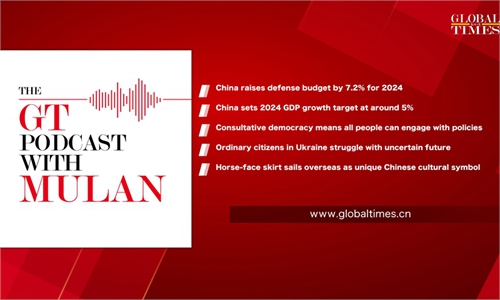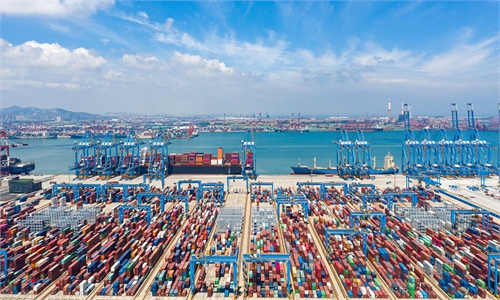
Illsutration: Liu Rui/GT
The Chinese government work report submitted on March 5 to the national legislature set an "around 5 percent" GDP growth target. This is a well-chosen target for several reasons that will be analyzed. But this target was immediately attacked in the Western media as extremely ambitious - with the Wall Street Journal declaring "China Sets High Bar for Growth," the Financial Times announcing: "little cause for optimism that China will achieve its 'around 5 per cent' this year."
The reason why some media outlets were keen to declare China's target growth rate as unrealistically high is because achieving it will destroy the remnants of their claims of "peak China" - the idea that China's economy has ceased to far outgrow economies in the West.
This is particularly sensitive in 2024 as the comparison of China's target with the projected growth rates of Western economies is already clear. Last year China's economy grew by 5.2 percent, while the US grew by 2.5 percent and the Eurozone by less than 1 percent. This means China's economy grew more than twice as fast as the US and more than five times as fast as the Eurozone.
Furthermore, in 2023, the US was growing above its trend rate. The US average annual growth in the last 10 years was over 2 percent, making it likely that the US economy will slow in 2024 - the IMF projects 2.1 percent growth, while the European Central Bank predicts Eurozone growth of less than 1 percent. Therefore, if China's economy grows at 5 percent, it will once again grow more than twice as fast as the US and five times as fast as the Eurozone. This explains the Western media's rush to claim that China's 5 percent target is unachievable. The problem for them is that the most fundamental economic processes show China's 5 percent target is entirely realistic.
An economy's growth rate is strictly determined by two numbers. The first is the proportion of GDP that must be invested for its economy to grow by 1 percent - technically, the economy's Incremental Capital Output Ratio (ICOR). The second is its percentage of fixed investment in GDP.
To give China's latest available figures, in the five years leading up to 2022, China's annual average GDP growth was 5.2 percent and fixed investment was around 42.4 percent of GDP. Therefore, 8.1 percent of GDP had to be invested for China's economy to grow by 1 percent - its ICOR was 8.1.
Full data is not yet available for 2023 but from available statistics, China's fixed investment was again around 40 percent of GDP or slightly above. Consequently, with 2023's 5.2 percent GDP growth, China's ICOR was again around 8.
Therefore, there is no need for China to improve on its 2023 performance to hit its 5 percent target - China's ICOR just has to remain around 8 and its investment at slightly over 40 percent of GDP.
This simultaneously defines the challenges that will be faced and explains specific emphases in the government work report.
China's efficiency of investment in creating GDP growth is one of the world's highest - ranking second among the world's 20 largest economies. In contrast, the US has to invest 10.3 percent of GDP for its economy to grow by 1 percent and Germany has to invest 41 percent. The first challenge for China is to maintain this extremely high investment efficiency - requiring policies including increasing even further the level of R&D spending, taking action against monopolies and maintaining a high level of competition including through still greater international.
The second challenge is to ensure that the investment level remains at over 40 percent of GDP. Last year, while overall investment grew, private investment did not. This was a weakness that must be addressed in 2024 and explains the attention paid in the work report to aiding the private sector.
But this data clearly shows no sensational and impossible results are required to achieve the 5 percent GDP target, as claimed in Western media. It simply means existing advantages in China's economy must be maintained and certain defined areas developed further.
The qualitative results of hitting such targets are also clear. China is now close to achieving the criteria of a high-income economy by international World Bank classification. The level for this is per capita gross national income of $13,846, while in 2023 China's per capita GDP was slightly above $12,600 - approximately 10 percent from this target. With growth rates of 5 percent, in two to three years' time, depending on exchange rate shifts, China will become a high-income economy by international standards. As China is 18 percent of the world's population, and the population of existing high-income economies is 16 percent, when China hits that target, it will contain more people living in a high-income economy than all other countries put together - an extraordinary fact!
This trend also means that China's economic development will be dominated by new production sectors - referred to as new quality productive forces in China - through the overall modernization of its economy and its role in key new global growth sectors. China already has the world's leading telecommunications company, Huawei. In reality, the US imposing sanctions against Huawei is an admission that Western companies cannot compete with the company. China overwhelmingly leads in green power, with 80 percent of world production in solar panels and 60 percent of wind turbines and electric-car batteries. As is well known, China in 2023 became the world's leading exporter of cars - an international industry formerly dominated by the high-income economies of Japan and Germany.
In short, by every criterion from economic fundamentals to the development of new productive sectors, China's goal of 5 percent growth in 2024 is entirely realistic.
The author is Senior Fellow at Chongyang Institute for Financial Studies, Renmin University of China. opinion@globaltimes.com.cn



